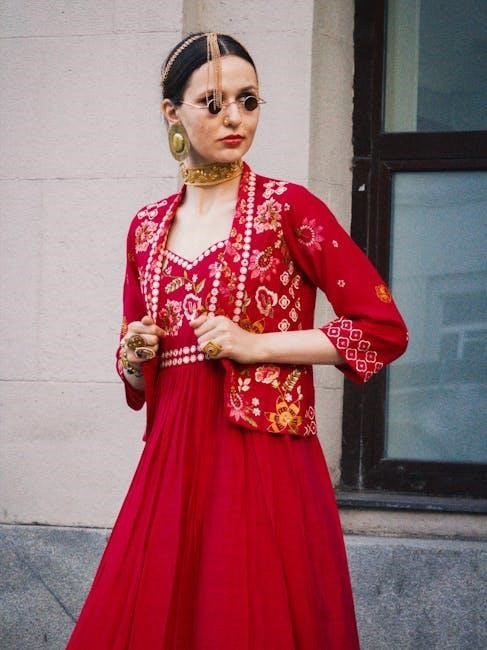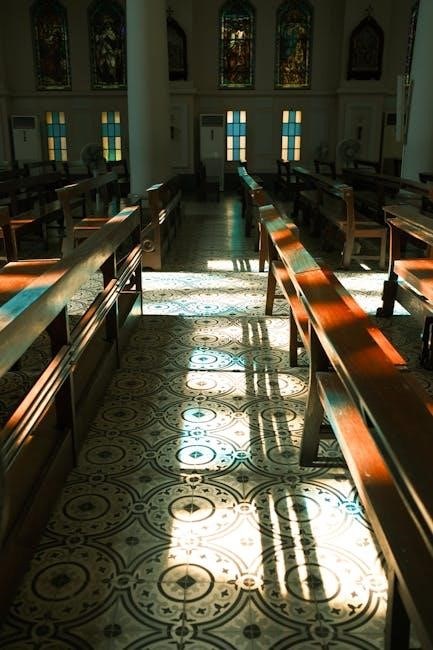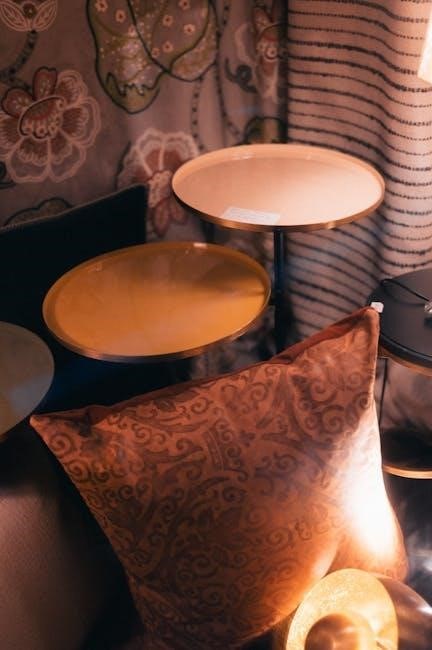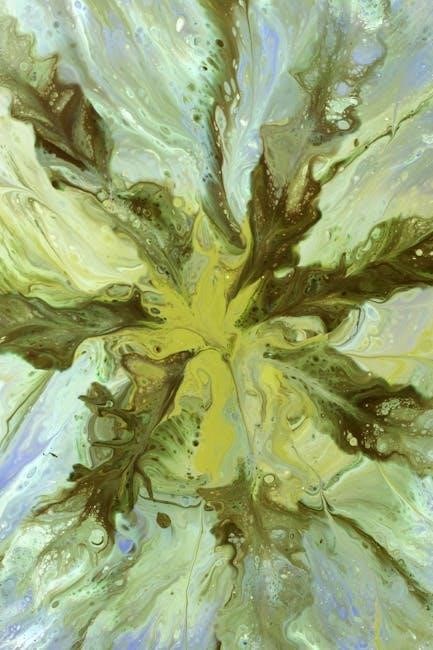Chrismons are ornaments with Christian symbols that honor Christ‚ used in Christmas decorations. They remind believers of the true meaning of Christmas‚ focusing on faith and spiritual reflection through their designs.
What Are Chrismons?
Chrismons are decorative ornaments that feature Christian symbols‚ designed to honor Jesus Christ and emphasize the religious significance of Christmas. These ornaments are typically used in church settings or homes to remind believers of the true meaning of the holiday. Unlike traditional Christmas decorations‚ Chrismons are specifically created to represent aspects of Christian faith‚ such as the cross‚ fish‚ dove‚ or Alpha and Omega symbols. They are often white and gold‚ symbolizing purity and royalty‚ respectively‚ and are frequently used on Christmas trees‚ wreaths‚ or other displays. Chrismons serve as both decorative elements and educational tools‚ helping to teach about Christianity and its core beliefs. They are also a popular craft project‚ with many patterns available for those who wish to create their own. By focusing on spiritual themes‚ Chrismons offer a way to celebrate Christmas with a deeper connection to faith and worship.

History and Origin of Chrismon Patterns
Chrismon patterns originated from Christian traditions‚ symbolizing faith and worship. They are used in church settings to celebrate the true meaning of Christmas‚ emphasizing spiritual reflection through their designs.
Origins of Chrismons

Chrismons‚ or Christian symbols‚ have their roots in early Christian art and traditions. They were initially used in churches to visually represent religious stories and teachings‚ making complex theological concepts accessible to all believers. Over time‚ these symbols evolved and were incorporated into various forms of worship and decoration‚ including the creation of ornaments for special occasions like Christmas. The term “Chrismon” specifically refers to ornaments that combine Christian symbols with festive designs‚ serving as reminders of the spiritual significance of celebrations. These ornaments often feature motifs such as crosses‚ doves‚ and fish‚ each carrying deep religious meaning. The origins of Chrismons can be traced back to the early Christian Church‚ where symbols played a vital role in communicating faith and fostering unity among believers. Today‚ they continue to be a meaningful way to express and celebrate one’s faith during the holiday season.
Historical Development of Chrismon Patterns
Chrismon patterns have evolved over centuries‚ rooted in early Christian symbolism. Initially‚ these symbols‚ such as the cross‚ fish‚ and dove‚ were used in art and worship to convey religious teachings. Over time‚ they became integral to Christmas decorations‚ blending spiritual meaning with festive traditions. In the mid-20th century‚ Chrismons gained popularity as churches began creating ornamental designs to adorn trees and sanctuaries. These patterns often combined traditional symbols with geometric shapes‚ reflecting both faith and artistry. The development of Chrismon patterns was influenced by cultural and religious practices‚ with designs varying across regions. Today‚ Chrismons are crafted using diverse materials‚ from felt and wood to metal‚ and are shared in workshops and guides. Their historical growth reflects a blend of faith‚ creativity‚ and community‚ making them a cherished part of Christian celebrations worldwide.
Religious Significance of Chrismons
Chrismons hold profound religious significance as symbols of Christian faith‚ particularly during Christmas. They are designed to remind believers of the true meaning of the season‚ which is the celebration of Jesus Christ’s birth. Each Chrismon ornament is carefully crafted with specific Christian symbols‚ such as the cross‚ the fish‚ or the dove‚ which carry deep spiritual meanings. These symbols serve as visual reminders of key teachings‚ events‚ and themes in Christianity‚ such as salvation‚ peace‚ and the Holy Spirit. The use of Chrismons in church decorations and personal devotions helps create a sacred atmosphere‚ fostering reflection and worship. They also serve as tools for sharing the Gospel‚ especially during festive gatherings. By incorporating Chrismons into their traditions‚ Christians honor their faith and pass on its values to future generations. Their presence in religious ceremonies and homes underscores the importance of keeping Christ at the center of Christmas celebrations.
Types of Chrismon Patterns
Chrismons come in various designs‚ including traditional Christian symbols like crosses and doves‚ geometric patterns‚ and abstract motifs. They can also be combined to create intricate and meaningful ornaments.
Christian Symbols in Chrismons
Chrismons often feature traditional Christian symbols‚ such as the cross‚ dove‚ and fish‚ which represent key aspects of faith. The cross symbolizes Christ’s sacrifice‚ while the dove signifies the Holy Spirit. Other symbols like the Alpha and Omega‚ Chi-Rho‚ and Crown of Thorns are also common‚ each carrying deep theological meaning. These symbols are carefully chosen to reflect the life‚ ministry‚ and resurrection of Jesus Christ‚ making Chrismons a meaningful way to celebrate the true essence of Christmas. They serve as visual reminders of faith and are often used in worship and home decorations to inspire reflection and devotion. The use of these symbols ensures that Chrismons remain a powerful tool for sharing the Gospel and honoring Christ during the holiday season.

Geometric and Abstract Designs
Geometric and abstract designs in Chrismons offer a modern twist to traditional Christian symbols. These patterns often feature intricate shapes‚ lines‚ and patterns that create visually striking ornaments. While they may not directly depict religious imagery‚ they still carry spiritual significance by representing the harmony and order of God’s creation. Abstract designs allow for creative interpretation‚ making them appealing to crafters who enjoy experimenting with shapes and colors. Geometric patterns‚ such as spirals or concentric circles‚ can symbolize eternity or unity. These designs often complement traditional Chrismon symbols‚ offering a balanced blend of faith and artistry; The use of beads‚ fabric‚ or metal in these designs adds texture and depth‚ making each Chrismon unique. By incorporating geometric and abstract elements‚ crafters can create ornaments that are both visually captivating and meaningful‚ appealing to a wide range of tastes and preferences while still honoring the essence of Chrismons.

Combination Patterns
Combination patterns in Chrismons blend multiple design elements‚ creating unique and layered ornaments that reflect a deeper spiritual meaning. These patterns often merge traditional Christian symbols‚ such as the cross or dove‚ with geometric or abstract designs‚ resulting in visually striking and thought-provoking pieces. By combining elements‚ crafters can create ornaments that tell a story or convey a specific message of faith. For example‚ a cross intertwined with vines or flowers may symbolize Christ’s resurrection and eternal life. These designs also offer versatility‚ allowing crafters to experiment with colors‚ materials‚ and textures. Combination patterns are particularly popular for their ability to make each Chrismon distinctive while maintaining a cohesive theme. They encourage creativity and personalization‚ making them a favorite among those who enjoy blending tradition with innovation. This approach ensures that Chrismons remain both meaningful and artistically appealing‚ inspiring reflection and admiration during the Christmas season.

Materials and Tools Needed
Common materials include paper‚ cardstock‚ glue‚ scissors‚ beads‚ and fabric. Essential tools are craft cutters‚ paintbrushes‚ and decorative items like ribbons or varnish to enhance the ornaments’ appearance and durability.
Common Materials for Making Chrismons
Creating Chrismons involves various materials that bring out the symbolic beauty of these ornaments. Paper and cardstock are popular choices for their versatility and ease of use‚ allowing intricate designs to be cut and shaped. Fabric is another common material‚ offering a soft‚ traditional look‚ especially when adorned with embroidery or appliques. Beads are widely used to add texture and visual interest‚ representing elements like the Trinity or divine light. Ribbons and bows can enhance the ornaments with color and elegance. Additionally‚ glue‚ scissors‚ and paint are essential for assembling and customizing the designs. Some crafters also use natural materials like wood or clay for a more rustic appeal. These materials are easily accessible‚ making Chrismons a delightful and accessible craft for both beginners and experienced makers alike.

Essential Tools for Crafting Chrismons
Crafting Chrismons requires a few essential tools to bring designs to life. Sharp scissors or craft knives are necessary for cutting intricate patterns from paper‚ fabric‚ or foam. A hot glue gun is ideal for securing beads‚ sequins‚ or other embellishments‚ ensuring a durable finish. Paint and paintbrushes are useful for adding color and detailing to symbols like crosses or doves. Tweezers can help place small beads or jewels precisely. A cutting mat or protective surface is recommended to prevent damage while cutting. Additionally‚ a ruler or straightedge is handy for aligning patterns or creating straight lines. For more complex designs‚ a sewing needle and embroidery floss can be used to stitch fabric ornaments. A printer and ink are also needed if using printed templates. Finally‚ a workboard or craft mat keeps materials organized. These tools make the process efficient and enjoyable‚ allowing creators to focus on the spiritual significance of their craft.
Creating Your Own Chrismon Patterns

Designing Chrismons involves combining Christian symbols with geometric shapes‚ creating meaningful ornaments. Start with a template or sketch‚ then customize with beads‚ fabric‚ or paint to reflect personal faith and creativity.
Step-by-Step Guide to Making Chrismons
Creating Chrismons begins with selecting a design‚ often inspired by Christian symbols like the cross or fish. Start by tracing the pattern onto fabric or paper. Cut out the shape carefully‚ ensuring precision for intricate details. Next‚ embellish the design with beads‚ sequins‚ or paint‚ symbolizing spiritual themes. Add a loop or string for hanging. For durability‚ apply a sealant or laminate. Finally‚ assemble all ornaments and display them in a meaningful arrangement. This process combines craftsmanship with faith‚ making each Chrismon a unique expression of devotion. The steps are simple yet meaningful‚ allowing artisans to reflect on the significance of each symbol as they create.
Customizing Chrismon Patterns
Customizing Chrismon patterns allows for personalized expressions of faith and creativity. Start by choosing a base design‚ such as a cross or dove‚ and adapt it to suit your preferences. Add embellishments like beads‚ sequins‚ or fabric paint to enhance the symbolism. For instance‚ a cross can be adorned with red beads to represent Christ’s sacrifice‚ while a dove can be adorned with white feathers for purity. Incorporating personal themes‚ such as favorite Bible verses or meaningful colors‚ makes each Chrismon unique. Experiment with materials like felt‚ wood‚ or metal to create varied textures and styles. Customization also allows for seasonal variations‚ such as adding snowflakes for winter or flowers for spring. This personal touch not only honors the Christian message but also makes each ornament a heartfelt gift or keepsake‚ reflecting individual spirituality and artistry.

Cultural and Religious Significance
Chrismons embody Christian faith and cultural heritage‚ serving as meaningful reminders of Christ’s significance during Christmas. They enrich celebrations‚ fostering a deeper spiritual connection and honoring religious traditions.
Chrismons in Religious Ceremonies
Chrismons play a vital role in religious ceremonies‚ particularly during Advent and Christmas. They are often displayed in churches‚ homes‚ and community gatherings to symbolize the true meaning of the season. These ornaments‚ adorned with Christian symbols such as crosses‚ doves‚ and fish‚ serve as visual reminders of Christ’s birth and teachings. In many churches‚ Chrismons are incorporated into worship services‚ where they are used to decorate altars‚ pulpits‚ and nativity scenes. Congregations often participate in crafting these symbols‚ fostering a sense of community and shared faith. During ceremonies‚ the unveiling of Chrismons can be a moment of reflection and spiritual renewal. They are also used in educational programs to teach children and newcomers about the significance of Christian symbols. By integrating Chrismons into religious practices‚ believers deepen their connection to the faith and celebrate the essence of Christmas with reverence and joy.
Chrismon patterns embody the spiritual essence of Christmas‚ offering a meaningful way to celebrate Christ’s birth; Their timeless appeal inspires faith and creativity‚ making them a cherished part of religious and cultural traditions.

Final Thoughts on Chrismon Patterns
Chrismon patterns are a beautiful way to connect faith and art‚ emphasizing the true significance of Christmas. They offer a creative outlet for crafting meaningful ornaments that reflect Christian values. By focusing on symbols like the cross‚ fish‚ and Alpha and Omega‚ Chrismons serve as reminders of Jesus Christ’s life and teachings. These patterns not only enrich holiday decor but also provide a way to share the Gospel through visual storytelling. Making Chrismons can be a meditative and fulfilling activity‚ fostering a deeper understanding of faith. Their simplicity and elegance make them accessible to crafters of all skill levels‚ from intricate designs to straightforward templates. Whether used in personal reflection or as gifts‚ Chrismons continue to inspire a sense of reverence and joy‚ making them a timeless tradition in Christian communities.
